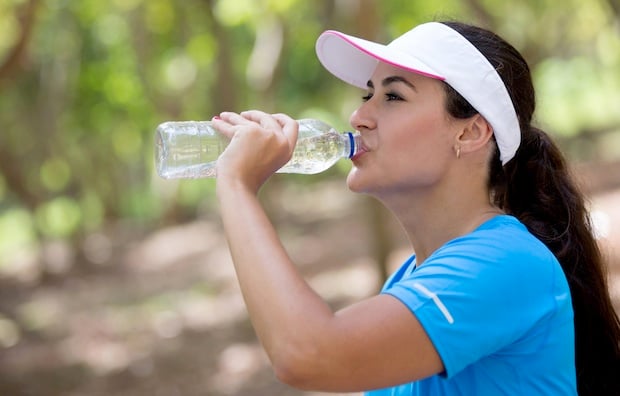Updated July 22, 2016, 5:09 p.m.
It’s H-O-T out there with temperatures hitting the 100s—as evidenced by our T-shirts soaked through with sweat by 7 AM. So what’s a runner to do? Because getting up by 4 AM to avoid a running meltdown does not sound appealing.
First things first, hydrate.
It won’t do you much good to hydrate in the middle of your run if you haven’t had a glass of water all day. The American College of Sports Medicine recommends drinking 16 to 20 ounces of fluid at least two or three hours before running. Then continue to drink periodically during the run.
To avoid cramping and to replenish electrolyte loss, local running coaches Julie Sapper and Lisa Reichmann often take some salt tabs—they recommend Enduralytes—or drink V8.
However, be careful that you don’t over-hydrate, they warn. If your stomach is sloshing while you run, wait a bit before drinking again.
Replenish fluids after run.
Just because the workout is over doesn’t mean you can toss that water bottle. Sapper and Reichmann recommend weighing yourself before and after a run. If you’ve lost weight post-run, you’re not hydrating enough beforehand. The ACSM recommends drinking 20 ounces of fluid for every pound of weight lost in exercise.
Expect to be slower for a couple of weeks.
Studies show that it takes about two weeks of training in warmer conditions for the body to acclimate. “This is why those runs during the first few days of DC heat and humidity feel so awful compared to runs in similar conditions in mid-July,” say Sapper and Reichmann. As a general guideline, expect your pace to slow by 10 seconds per mile per every 10-degree increase in temperatures above 60 degrees.
Ice down.
During summer races, Reichmann and Sapper wear visors and grab ice at water stops to put under their hats and in their sports bras. Alternatively, consider running with an ice-cold water bottle. A 2012 study found that by holding a freezing bottle of water, exercisers were more likely to work out longer.
Wear light-colored clothing.
Stick to light-colored clothing to reflect the sun away from your body. Running coach Mike Hamberger writes that it’s okay to run shirtless or just in a sports bra, but be warned that the “direct rays against your skin will add to your core body temperature.”
Use sunscreen.
You’d be surprised how many people forget to apply sunscreen and come back looking like a lobster after a run. We have a great roundup of sunscreens to try, including Mission SPF 30+ No Sting Sunscreen Facestick. It’s been tried and approved by athletes such as Serena Williams and Mia Hamm, and it doubles as a lip protector.
Know when to stop.
If you start feeling extremely thirsty, irritable, or dizzy or experience muscle cramps, it’s time to call it quits. You could be experiencing dehydration, heat stroke, or heat exhaustion.



















